With its latest 4.7-inch and 5.5-inch iPhone models, Apple is for the first time launching two new smartphone form factors simultaneously, broadening the usual upgrade cycle choices beyond storage capacity and color. It also makes deciding that much more difficult.
Prior to the iPhone 6 and iPhone 6 Plus, Apple's smartphone product cycle upgrade options were limited . The company broke tradition by introducing a lower-tier smartphone in last year's iPhone 5c, though the device was essentially a previous-generation iPhone 5 repackaged in bright polycarbonate shells.
This year, however, Apple is offering two similar, yet distinct options. Both boast redesigned internal and external design and are separated by screen size, features and price. Further confusing matters are iPhone 6 Plus-specific features like optical image stabilization (OIS) for the rear-facing iSight camera and a tweaked user interface crafted to better take advantage of the larger screen.
Two of a kind
For the most part, components for the iPhone 6 and 6 Plus come from the same parts bin. Both handsets, for example, use a 1.4GHz A8 system-on-chip processor, advanced wireless communications suite, Touch ID, M8 motion coprocessor and Sony-sourced 8MP camera sensor. New capabilities like NFC for Apple Pay also comes standard.
As noted by AppleInsider's reviews, benchmark test scores were nearly the same, though the iPhone 6 Plus did notch a higher overall average.
Aesthetically, both phones feature curved glass displays, rounded edges and a thin profile. The 6 Plus is thicker at 7.1 millimeters compared to the 6.9-millimeter iPhone 6, but the variation is unnoticeable in the hand.
Coming from a 4-inch iPhone 5s, formerly the largest iPhone available, both new handsets take some getting used to. The iPhone 6 feels large, but is manageable after modifying hand placement and carry style. For example, we tend to grab across the entire width of the phone when performing basic navigation and scrolling actions, while adjusting upward to a cradle position to target the top of the screen. Users will need to adjust to the new form factor, but the learning curve is not steep.
The iPhone 6 Plus, however, is an entirely different beast. Unless you have extraordinarily large hands, the 6 Plus requires two-handed operation for nearly every action aside from navigating the home screen. Even typing in portrait mode is a tall order.
Apple, predicting problems users would likely encounter when using a large-screened device, built the Reachability feature into both iPhones. A double-tap gesture on Touch ID home button pulls the GUI down toward the middle of the display, allowing access to the icons on the top row, browser address boxes and other objects. Touted as a system-wide tool, Reachability can be used in almost every situation save for Notification Center.
That Apple chose to not incorporate the function with notifications is disappointing as it limits one-handed access to new iOS 8 Notification Center functions like transient interactive message alerts.
Differences
Aside from phablet and near-phablet form factors, the iPhone 6 and 6 Plus have three major differences as far as hardware is concerned: screen size and quality; camera functions; and battery life.
Screen
Somewhere between the 4-inch iPhone 5 and 7.9-inch iPad mini with Retina display, the new iPhone models fit two distinct niches and are both new and unfamiliar form factors for longtime iOS device users.
Close-up of iPhone 6 Plus Retina HD display.If screen size and quality is all you care about, then the iPhone 6 Plus is the way to go. The 5.5-inch Retina HD display is the clearest, most accurate panel Apple has put in a portable device to date. Period. The iPhone 6 is no slouch with its 4.7-inch 1,334x750-pixel good for a 326ppi pixel density, but the iPhone 6 Plus is even more pixel-dense at 1,920-by-1,080 pixels and 401ppi.
For most users, the additional 75ppi is hardly noticeable, but after seeing a side-by-side comparison and constantly switching between handsets for a few days, we started to see minute discrepancies with the iPhone 6 screen. We can't make out individual pixels from normal viewing distance, but on the 4.7-inch display we are able to discern very slight jagged edges on curved lines, whereas the 6 Plus is tack sharp. To be clear, the effect is very slight and would likely go unnoticed by normal users.
Along with resolution, the 6 Plus model we tested showed "cool" whites, while the iPhone 6 was markedly warmer. Tested against a 15-inch MacBook Pro with Retina display, both handsets were much warmer, pushing toward a muted yellow tint by comparison.
Camera
Mentioned above, both new iPhones sport a Sony backside-illuminated 8MP sensor with onboard image processing handled by Apple's A8 SoC. Possibly thanks to its larger chassis, or merely supplied as a feature differentiator, Apple opted to build in an optical image stabilization mechanism for the 6 Plus.
Unedited images out of iPhone 6 (left) and iPhone 6 Plus with OIS.In its OIS implementation, Apple uses motion data gathered from the onboard gyroscope and M8 motion coprocessor to detect shaking and other unwanted movement that could cause photo blur. The system sends the data to actuators attached to the iSight's lens group, which moves in in equal and opposite directions of detected shaking to stabilize the picture.
In our tests, Apple's OIS solution was extremely effective in creating steady video clips, but most impressive in low-light conditions. Thanks to OIS, the iSight camera's shutter can stay open for longer periods of time compared to the non-stabilized iPhone 6, letting in exponentially more light. The result is clearer, brighter and more color-accurate image reproduction from dimly-lit scenes.
In concert with OIS, the big, bright 5.5-inch display is great for in-the-field photo and video editing. It won't replace a DSLR or even mirrorless camera systems, but raw image quality out of the 6 Plus rivals that of high-end digital point-and-shoots.
Battery
As can be expected, larger displays require bigger, more powerful batteries and the new iPhones are no exception. Compared to the iPhone 5s' 1,440mAh battery, the iPhone 6 boasts an 1,810mAh cell, while the iPhone 6 Plus comes with a gigantic 2,915mAh unit.
We expected the iPhone 6 to outperform the power-hungry iPhone 6 Plus with its pixel-dense LCD panel, but that wasn't the case. In fact, during daily use, the 5.5-inch iPhone lasted nearly one day longer than its 4.7-inch sibling, which itself went for about a day and a half without needing to plug in.
Our stress tests, which included a barrage of video streaming, game playing and constant up-time with screen brightness set to maximum output, evened the score with both devices lasting for about one work day. Still, considering the level to which the 6 Plus has to drive its backlight, battery life is outstanding.
User interface
Apple's next-generation iOS 8 mobile operating system was built to take advantage of the latest iPhones' larger displays. Both phones feature tweaked keyboards with rearranged layouts and additional buttons, as seen below. While the iPhone 6 gains dedicated undo, emoji and cursor control buttons, the 6 Plus packs in even more, including cut and paste keys.
Unfortunately, Apple does not yet allow split keyboard configurations for the larger 6 Plus, which would have been a nice addition for landscape orientation typing. As it is, our hands have trouble reaching "G" and "H" due to the new — and arguably extraneous — keys crammed in on the sides.
Also exclusive to the 6 Plus are split-pane app windows. In first-party apps like Mail, Messages and Contacts, using the phone in landscape invokes a dual-pane viewing mode for quick access to email threads, friends lists and more. Apple borrowed the capability from iOS on iPad.
iPhone 6 Plus has a few more miscellaneous device-specific functions, like landscape home screen viewing and tabbed browsing in Safari, but overall we feel as though Apple missed a big opportunity to innovate with its phablet GUI.
Making a decision
People Jonesing for an Apple phablet probably have their hearts set on the 6 Plus; it's the yearly or biyearly upgraders and stalwart iPhone users that may have trouble deciding between the two.
It may sound trite, but choosing a new iPhone 6 model really depends on personal preference. By keeping internal hardware so similar, Apple has enabled potential customers to narrow their decision based on personal preferences like screen size, usability and portability. The iPhone 6 Plus does have a higher-resolution screen and and hardware-stabilized camera, but those features are likely not deal breakers for most users, especially when put up against portability and user-friendly design.
 Mikey Campbell
Mikey Campbell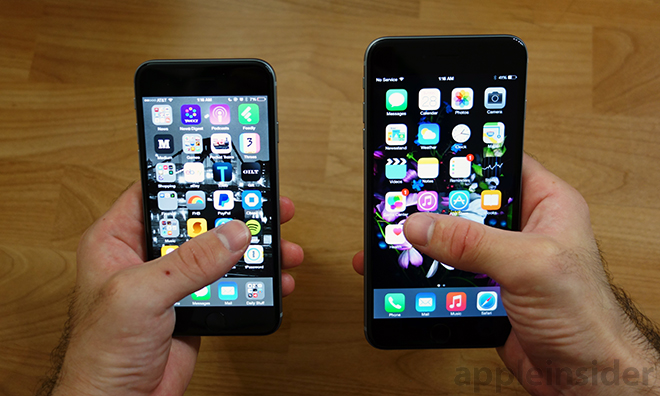
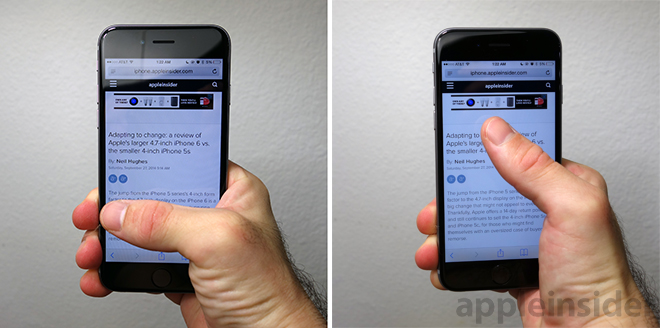
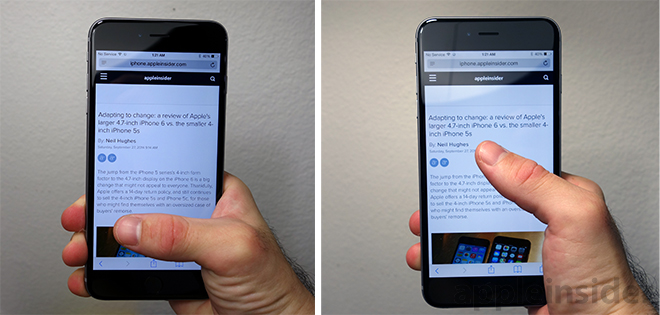
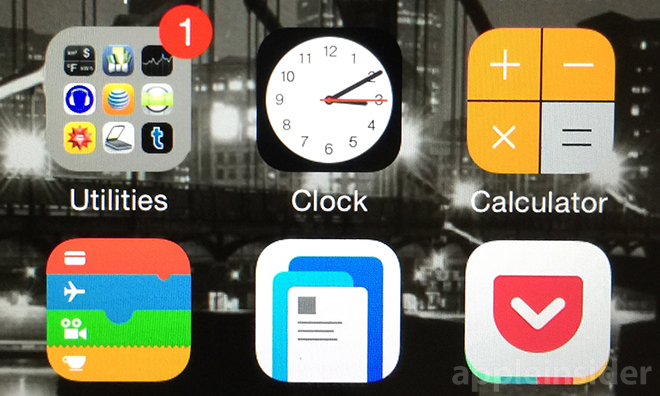
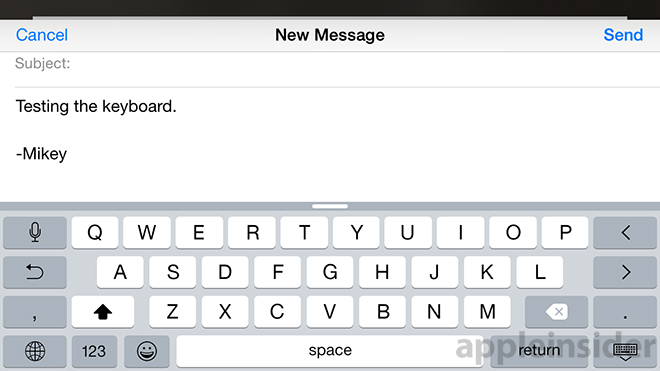








-m.jpg)






 Brian Patterson
Brian Patterson
 Charles Martin
Charles Martin


 Malcolm Owen
Malcolm Owen
 William Gallagher
William Gallagher
 Christine McKee
Christine McKee
 Marko Zivkovic
Marko Zivkovic









160 Comments
...narrow their decision based on personal preferences like screen size, usability and portability. The iPhone 6 Plus does have a higher-resolution screen and and hardware-stabilized camera...
and substantially better battery life.
but those features are likely not deal breakers for most users, especially when put up against portability and user-friendly design.
Ok, I will fix it for you: but those features are likely not deal breakers for most users, especially when put up against the fact that 6 Plus can be used as a tablet and a phone at the same time, which in most cases eliminates a need in iPad.
iPhone 6 Plus 64GB = $850
iPhone 6 64GB + iPad Mini (cellular) = $1,279+
1) great review 2) I don't think the 5.5" is really usable as a phone, like old school phone, a device you grab 20+ times a day and needs to be easy to grab and tuck away. 3) [quote name="AppleInsider" url="/t/182553/going-big-a-review-of-apples-apples-new-4-7-iphone-6-vs-the-5-5-iphone-6-plus#post_2608952"]For most users, the additional 75ppi is hardly noticeable, but after seeing a side-by-side comparison and constantly switching between handsets for a few days, we started to see minute discrepancies with the iPhone 6 screen. We can't make out individual pixels from normal viewing distance, but on the 4.7-inch display we are able to discern very slight jagged edges on curved lines, whereas the 6 Plus is tack sharp. To be clear, the effect is very slight and would likely go unnoticed by normal users.[/quote] I think that won't be an issue for anyone buying the 6 (not +) It would indeed need a comparison to discern the pixels . 4) I think they're both too large. But the world is moving to less communication and more to texting, so I guess I'm getting old. I prefer to talk, taking away any misunderstanding of my words at the other end.
and substantially better battery life.
Ok, I will fix it for you: but those features are likely not deal breakers for most users, especially when put up against the fact that 6 Plus can be used as a tablet and a phone at the same time, which in most cases eliminates a need in iPad.
iPhone 6 Plus 64GB = $850
iPhone 6 64GB + iPad Mini (cellular) = $1,279+
I love my 6 Plus, but it does not take the place of my iPad Air. I am glad the 6 Plus is now much more usable than my 5s was for more tasks....but the iPad continues to have a big role.
I like it that way.
People that don't have an iPad Air and instead an iPad mini....well I'm not as certain they need both devices.
I don't even know how you call that thing a phone. It's preposterous that they'd dedicate the resources to building the Plus while neglecting to make a 4 inch iPhone 6. Apple has gone from trendsetter to follower.
[quote name="jason98" url="/t/182553/going-big-a-review-of-apples-apples-new-4-7-iphone-6-vs-the-5-5-iphone-6-plus#post_2608959"] and substantially better battery life. Ok, I will fix it for you: but those features are likely not deal breakers for most users, especially when put up against the fact that 6 Plus can be used as a tablet and a phone at the same time, which in most cases eliminates a need in iPad. iPhone 6 Plus 64GB = $850 iPhone 6 64GB + iPad Mini (cellular) = $1,279+ [/quote]The 6 Plus is as much of a tablet as those crappy 7 inch Android "tablets" that failed to compete with the iPad. It's the type of tweener product that Steve shunned, it makes for neither a good phone or a good tablet.